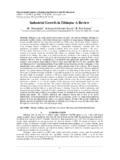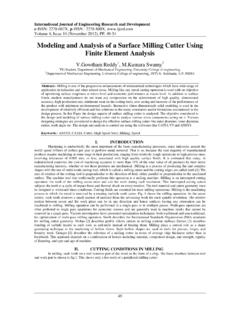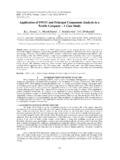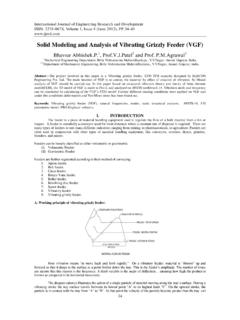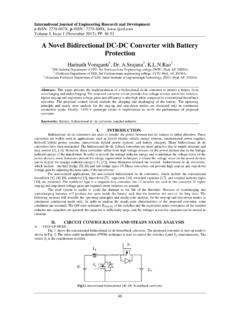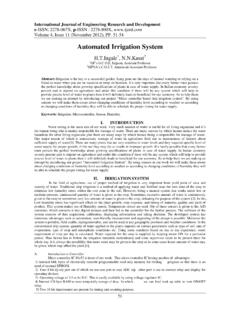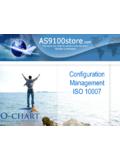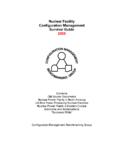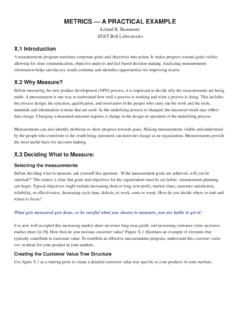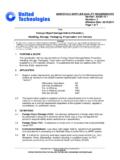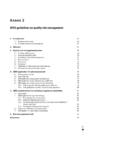Transcription of Effective Implementation of Total Productive Maintenance ...
1 International Journal of Engineering Research and Development e-ISSN: 2278-067X, p-ISSN: 2278-800X, Volume 8, Issue 1 (July 2013), PP. 01-09 1 Effective Implementation of Total Productive Maintenance and Impacts on Breakdown Time and Repair & Maintenance A Case Study Of A Printing Industry In Bangladesh Iftekhar Aziz1, Sazedul Karim2, Md. Mosharraf Hossain3 1 Avery Dennison Bangladesh Ltd., 167-169 DEPZ-Ext Area, Savar, Dhaka, Bangladesh 2 Avery Dennison Bangladesh Ltd., 167-169 DEPZ-Ext Area, Savar, Dhaka, Bangladesh 3 Department of Industrial & Production Engineering, Rajshahi University of Engineering & Technology, Bangladesh. Abstract:- To sustain today s highly competitive market, every company must minimize its operating expenses.
2 Total Productive Maintenance (TPM) can play an Effective role in this aspect. The main purpose of this study is to find out a proper planning system for implementing TPM at the initial stage in the organization. This study discusses the important key performance indicators or KPIs of TPM, which are Machine Breakdown time, Mean Time between Failure (MTBF),Mean Time to Repair (MTTR) and Breakdown time percentage of available time. The case study of TPM Implementation has taken from a manufacturing company in Bangladesh that has started implementing TPM since January 2011. Significant improvements of these KPIs are contrasted with previous year s values.
3 This study explains how TPM transforms an industry s overall Maintenance system to increase the productivity. Keywords:-TPM, MTBF, MTTR, Break Down Time. I. INTRODUCTION Maintenance is one of the areas in modern management to increase machine productivity and to produce quality products. This obviously improves equipment efficiency rates and reduces costs (Lemma, 2008). Maintenance in a particular section could not provide much improvement. This insists to go for Maintenance in all departments which eventually leads to Total Preventive Maintenance (TPM). TPM concept developed from Productive Maintenance (PM), which was originated in United States in the late 1940 s and early 1950 s.
4 At that time, they developed Productive Maintenance schedule. After the Second World War, when Japanese companies were struggling with their costs, in 1953 twenty Japanese companies formed a PM research group; in 1962 they were sent to USA for doing research in PM system. They created the Japanese Institute of Plant Engineers (JIPE), later that became Japanese Institute for Plant Maintenance (JIPM) in 1969. Nippondenso, a Japanese automotive component manufacturer, one of the part of Toyota, first used the term Total Productive Maintenance in 1961 and later it won JIPM PM Prize for TPM Implementation . Nissan and Mazda followed the tool TPM. In 1970, when Japanese economy faced macabre TPM began to flourish in all Japanese companies.
5 In 1980 s and 1990 s TPM became popular in America and the Western World as a part of Total Quality Management. Dupont, Exxon, Kodak, Acoa, AT&T, Ford, Hewlett-Packard, Proctor and Gamble are some of the companies who believed in TPM and implemented TPM. The popularity and the effectiveness of TPM in recent time are beyond questions (Pomorski, 2004). II. LITERATURE REVIEW To ensure smooth running of production facility Maintenance is an important aspect. Total Productive Maintenance is stepwise strategy that combines best features of Productive and preventive Maintenance with Total employee engagement. TPM prevents losses before occurring to achieve zero defects, zero accidents and zero breakdowns (Suzuki, 1992).
6 Companies around the world accept TPM to abate production losses caused by machine breakdowns, as they believe the concept of zero breakdowns is possible to achieve (Wllmott and McCarthy, 2001). TPM is an Effective tool of converting traditional boss-subordinate management into a participative management style. It helps to create the ownership of the machine to the machine operators, which helps to enhance the skill label of operators with cooperation of Maintenance personnel. It is a paradigm shift from the typical perceptions of who is responsible for Maintenance . TPM has to be implemented by all departments including operations, Maintenance , environmental, purchasing, accounting, stores, safety and human resources; in a word, TPM involves every employee, from top management to shop floor employees Effective Implementation of Total Productive Maintenance and Impacts on Breakdown 2 (McKone et al, 2001).
7 TPM changes the mind set up of the people. It shifts the traditional attitude of the operators I operate-you fix to I operate-I fix style (Thun, 2006). TPM involves Maintenance persons and operators together, where Maintenance department does general breakdown servicing and operators take the ownership of the machines (Taisir, 2010). The losses that are experienced by each industry are different. In general, the losses can be categorized into 16 major types under 4 categories that elaborately describe all aspects of losses (Venkatesh, 2007). Those four main categories are Seven major losses that affect overall equipment efficiency, Losses that affect equipment loading time, Five major losses that affects human work efficiency and Three major losses that affects Effective use of production resources.
8 In TPM, operators and Maintenance personnel work together to attain fixing any abnormalities that are found in the equipments. TPM combines the best features of preventive Maintenance , condition based Maintenance and predictive Maintenance . All of these actions are ensured through eight pillars that actually thrive the deployment of TPM (Lazim et al, 2008). The 8 pillars of TPM may be summarized as Focused Improvement & Process Improvement, Autonomous Maintenance , Planned Maintenance , Quality Maintenance , Early Equipment Management, Education and Training, Safety, Health and Environment and TPM in office (Rodrigues and Hatakeyama, 2006).
9 There are number of metrics for TPM. As per company strategy, KPIs are selected. The most important KPIs are MTBF (Mean Time between Failures), MTTR (Mean Time to Repair), and Overall Equipment Effectiveness (OEE) (Baluch et al, 2010). Sometimes, machine breakdown time status, setup time status are also considered as important KPIs of the plant which help to meet desired cycle time and on time delivery. Overall equipment effectiveness is a function of availability, performance and quality indexes. OEE can be increased by reducing the losses (Jeong and Phillips, 2001). OEE = Availability * Performance * Quality. MTBF (Mean Time between Failures) is an index that indicates mean time between two separate failures (Rodrigues and Hatakeyama, 2006).
10 MTTR (Mean Time to Repairs) is an index that indicates mean time taken to repair the equipment (Rodrigues and Hatakeyama, 2006). III. RESEARCH METHODOLOGY Each research problem is in some way unique, and therefore requires a tailored research procedure. The first step in doing this research was the formulation of the problem and the creation of the research questions. Thereafter, identify the methodology which would best fit the problem under research. After that, gathered secondary data in the form of books and articles in order to improve understanding of the research problem. This study identifies unplanned machine breakdown time, MTBF, MTTR and Percentage of Breakdown time of Available time as most important attributes that not only improve machine OEE but also reduce Maintenance and repairing costs as well as make quick response on the breakdown.
